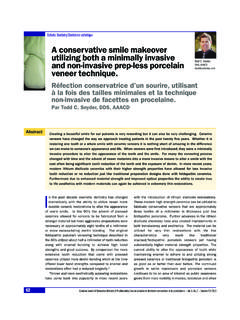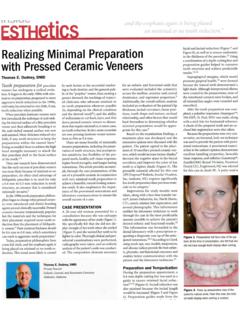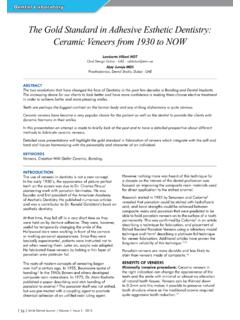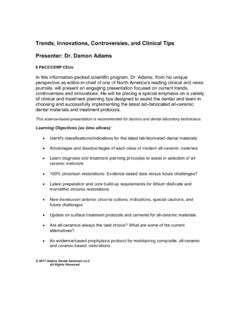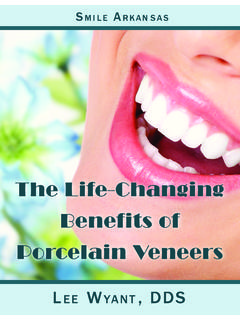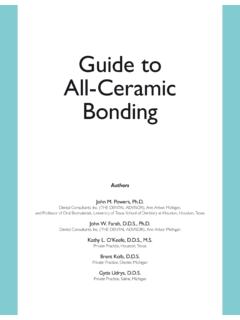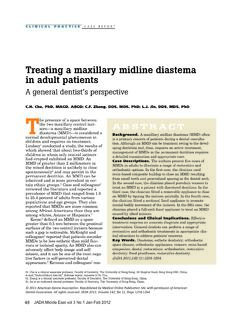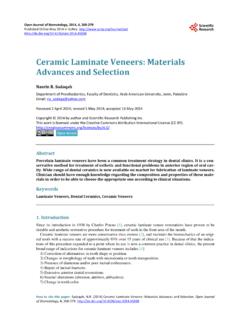Transcription of A conservative smile makeover utilizing both a minimally ...
1 May 2013A conservative smile makeoverutilizing both a minimallyinvasive and non-invasiveprep-less porcelain SnyderIn the past decade cosmetic dentistryhas changed dramatically with theability to utilize newer more durableceramic restorations to alter theappearance of one s smile . In the 90 sthe advent of pressed ceramics allowedfor veneers to be fabricated from astronger material but more aggressivepreparations were necessary atapproximately eight tenths of amillimeter or more necessitating dentinbonding. The original feldspathicporcelain veneering technique describedin the 80 s utilized about half amillimeter of tooth reduction alongwith enamel bonding to achieve highbond strengths and great success.
2 Bycomparison the more extensive toothreduction that came with pressedceramics utilized more dentin bondwhich at the time offered lower bondstrengths compared to enamel andrestorations often had a and more aestheticallyappealing restorations have come backFig. 1 Fig. 2 Fig. 3 May 201353into popularity in more recent yearswith the introduction of lithiumdisilicate restorations. These modernhigh strength ceramics can be utilizedto fabricate conservative veneers that areapproximately three tenths of amillimeter in thickness just likefeldspathic porcelains.
3 Furtheradvances in the lithium disilicatechemistry have also createdimprovements in both translucency andaesthetics. The material can be utilizedfor very thin restorations with life likecharacteristics very much liketraditional stacked/feldspathic porcelainveneers yet having substantially highermaterial strength properties. Thecurrent ability to alter the appearance ofteeth while maintaining enamel toadhere to and utilizing strong pressedceramics or traditional feldspathicporcelain is as good as or better thanever before. The continued growth insmile makeovers and porcelain veneerscontinues to be an area of interest aspublic awareness grows from morevisibility in movies, television and othermedia.
4 Based on aesthetics, strengthand technique there are many optionsavailable to alter our patientsappearance, but more importantly thatanyone can offer the procedure whereapplicable with minimal to no damageof the tooth structure. Through propertraining and the use of talentedtechnicians we can make incrediblechanges in a patient s appearance andrecreate beautiful, natural smiles toenhance their lives far better than theycould ever imagine while beingminimally invasive. In this case a patient presents postorthodontic therapy with the desire toclose spaces, change the shape andremove unsightly decalcifications on theanterior teeth.
5 The patient presentedwith no periodontal disease and a stableposterior occlusion, but has minimalcanine guidance. The treatment planwould be to have the patient s teethcleaned followed by impressions tocreate four sets of diagnostic first set would remain untoucheddocumenting how the case originallypresented. The second set would beused to fabricate custom whiteningtrays for the patient to use at homeprior to starting the case while thediagnostic waxup was being third set of models would be to useas a practice preparation model wheretesting of the hypothetical veneerdesign takes place.
6 The fourth set ofmodels would be sent to the laboratoryfor a diagnostic waxup where themodels would be waxed to idealcontours (while taking into account thepatient s desired appearance) so that jigsand reduction guides could are many ways to work up acosmetic case diagnosis and treatmentplan. Photographs of the case are veryimportant to the diagnostic process inevaluating shapes, color and overallappearance in relation to the templates and smile designbooks can assist in development anddiscussion with the patient and ceramistas to the desired final appearance of therestorations.
7 Additionally digitalphotographs can be measured andevaluated for symmetry and proportionwhere modifications, possible treatmentprocedures and outcomes can behypothesized and created. Outlines ofvarious teeth shapes can be overlaidonto the existing dentition digitallywhereby the aesthetics and positions ofteeth and gums can be evaluated morethoroughly by the dentist, specialists,technicians and the patient. Ultimatelya diagnostic wax-up needs to be createdby using the various forms of input onshape, texture, color, translucency diagnostic wax-up, uponapproval from the patient, is consideredthe final treatment plan and can thenbe used to fabricate a template to createan actual mockup on the patient of thefinal shape/appearance for furtherevaluation and verification.
8 In this casethe maxillary incisors were in afavorable position facially and addingan additional layer of porcelain wasdetermined to position the facialsurfaces out further than what would beaesthetically pleasing. These teethwould need minimum reduction toresurface the facial aesthetics and add tothe incisal edges. The canines weredetermined to be deficient bilaterallyfrom the center line of the tooth to themesial contact along with the incisaledge needing to be on the diagnostic wax-up andthe preparation designs attempted onthe diagnostic models the dentist andceramist can determine the type ofmaterial to be utilized and anyunforeseen problems or hypotheticalsituations can be discussed prior tostarting the case.
9 Feldspathic porcelainwhich has a flexural strength ofapproximately 80 mpa can be usedwhen very minimal porcelain isextended off of tooth structure. Leucitebased ceramics offer about 125-180mpa. Lithium disilicate ceramics have aflexural strength of approximately 360-400 mpa and are ideal for conservativeveneers or ones that require morestrength when lengthening teeth orreplacing larger amounts ofunsupported tooth first step in this case was to havethe patient s teeth cleaned May 2013 Fig. 6 Fig. 5 Fig. 4 Fig. 7 Fig. 8 May 2013polished.(Fig 1-6) Next we had herwhiten her teeth at home using thecustom fabricated whitening trays untilshe achieved a plateau in approximately10-14 days.
10 The color selection needsto be taken approximately 10-14 daysafter whitening to allow enough timefor the color to stabilize. Furthermoreno adhesive dentistry should beperformed on teeth for two weeks afterwhitening as bond strengths may becompromised from the the patient is whitening fortwo weeks the diagnostic models (Fig 7)are being waxed to ideal shapes basedon input from the patient as well as adigital final diagnosticwax-up was presented to the patientduring the two week whitening follow-up.(Fig 8) Based on the patient sapproval we will receive anauthorization signature to moveforward with the case using the wax-upas a template by the patient so that wecould then fabricate depth reductionguides, a beadline provisional template,custom impression tray and assortedjigs for the master anesthetic (2 carpules 2%Lidocaine w/ 1:100,000 epi) was to preparing the teeth aperiodontal probe is used to sound tobone anywhere that an interproximalcontact needs to be created or a gingivalembrasure black triangle needs to beclosed.
